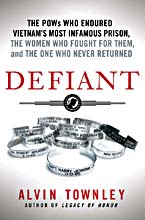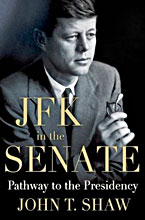|
 |
Books in Review, January/February 2014
The Couple Who Wouldn’t Quit On The Stolen Valor Act
REVIEWS BY MARC LEEPSON
 It’s no secret that during the Vietnam War the overwhelming majority of draft-age American males did everything they could to get out of fighting in the nation’s most controversial overseas war. Then, strangely and ironically, a few decades after the war ended the wannabe phenomenon arose. Men who never served in the military, or who served away from the action, claimed that they had fought (inevitably heroically and with high honors) in the Vietnam War. It’s no secret that during the Vietnam War the overwhelming majority of draft-age American males did everything they could to get out of fighting in the nation’s most controversial overseas war. Then, strangely and ironically, a few decades after the war ended the wannabe phenomenon arose. Men who never served in the military, or who served away from the action, claimed that they had fought (inevitably heroically and with high honors) in the Vietnam War.
What’s behind the wannabe phenomenon? Doug Sterner and his wife Pam Sterner address that question in Restoring Valor: One Couple’s Mission To Expose Fraudulent War Heroes and Protect America’s Military Awards System (Skyhorse, 262 pp., $24.95). The book tells the story of how the Sterners worked for years lobbying Congress to enact the Stolen Valor Act, and also details their personal efforts to unmask Vietnam War and other wannabes.
Why do imposters do it? “My response to this question,” Doug Sterner writes, “is because they can! The lack of proper record keeping in the services, the limited access to the truth by the public, and the inherent desire not to question a veteran’s service make stolen valor easy to get away with.”
Fraudsters, he says, “build upon their fraud because of what they derive from it. The questions of benefiting personally should be moot. If people did not benefit from claiming to be military veterans, wounded warriors, or decorated heroes, they’d quit doing it… It is fed and maintained by need and greed.”
In December 2006 when Congress passed the Stolen Valor Act making it illegal to lie about one’s military service, Roll Call magazine wrote: “In a Frank Capra-esque unfolding of events, Pam Sterner and her husband, Doug, turned a long-shot piece of legislation into reality. It took countless meetings, phone calls, faxes, and even a trip to Washington, D.C., [from their home in Colorado] to lobby in person, but all of that effort helped the Sterners—two self-described ‘ordinary people’—achieve something that very few people outside the political arena ever do.”
The Sterners explain how, after several legal challenges, the U.S. Supreme Court ruled the first Stolen Valor Act unconstitutional in June 2012 on First Amendment grounds. Congress took up a revised version of the statute, which President Obama signed into law on June 13, 2013. The new act narrows the law’s focus by making it a federal crime to misrepresent one’s military service “with the intent to obtain anything of value.”
In this readable book filled with reconstructed dialogue, the self-described “fraud busters” offer many examples of how Doug Sterner, a two-tour Vietnam veteran who served with the 14th Engineer Battalion, has helped uncover the real stories of men who falsely claimed they earned high military decorations (including the Medal of Honor). The Sterners include appendices on how to ferret out wannabes and how to navigate what can be a daunting maze of official records to do so.
DEFIANCE
 The fates of the hundreds of American pilots and other air crewmen shot down over North Vietnam and held prisoner in the infamous Hanoi Hilton is one of the best-known and widely described aspects of the Vietnam War. A ton of memoirs by former POWs, biographies of former POWs, and accounts of groups of POWs have appeared since the men were released en masse in 1973. The fates of the hundreds of American pilots and other air crewmen shot down over North Vietnam and held prisoner in the infamous Hanoi Hilton is one of the best-known and widely described aspects of the Vietnam War. A ton of memoirs by former POWs, biographies of former POWs, and accounts of groups of POWs have appeared since the men were released en masse in 1973.
Alvin Townley’s Defiant: The POWs Who Endured Vietnam’s Most Infamous Prison, the Women Who Fought for Them, and the One Who Never Returned (Thomas Dunne, 432 pp., $27.99) falls in the third category. This well-written account, which draws heavily on the previous body of POW literature, focuses on about a dozen captives. It also goes over the oft-told story of the POW wives at home who, against long odds, successfully lobbyed the government on their husbands’ behalf.
Much of the narrative looks at two of the longest-held and most renowned POWs, James Bond Stockdale (who wrote three memoirs, including In Love and War with his wife Sybil) and Jeremiah Denton (who told his story in When Hell Was in Session). Townley recounts, in detail, how Stockdale, Denton, and the other POWs endured years of almost unimaginable physical and mental torture, and the ways the men coped with the physical pain and emotional torment.
Townley, the author of a book about the legacy of Eagle Scouts, writes reverently of the POWs—whom he calls “American stalwarts,” “defiant patriots,” and “corralled incorrigibles”— in a fast-flowing narrative with much reconstructed dialogue.
SENATOR JFK
 John T. Shaw’s JFK in the Senate: Pathway to the Presidency (Palgrave Macmillan, 228 pp., $26) is a well-written, pioneering look at President John F. Kennedy’s 1953-60 tenure as the junior U.S. Senator from Massachusetts. Kennedy “participated actively and sometimes boldly” during his time in the Senate “in the central policy debates of his time,” Shaw notes. That included “France’s faltering military interventions in Vietnam and Algeria” and “the appropriate defense posture for America during the Cold War.” John T. Shaw’s JFK in the Senate: Pathway to the Presidency (Palgrave Macmillan, 228 pp., $26) is a well-written, pioneering look at President John F. Kennedy’s 1953-60 tenure as the junior U.S. Senator from Massachusetts. Kennedy “participated actively and sometimes boldly” during his time in the Senate “in the central policy debates of his time,” Shaw notes. That included “France’s faltering military interventions in Vietnam and Algeria” and “the appropriate defense posture for America during the Cold War.”
Kennedy had a decidedly negative view of the French war in Vietnam. He strongly favored “check[ing] the southern drive of communism,” there. But JFK said he did not want to do that relying “on the force of arms.” Rather, Kennedy called for building “strong native non-communist sentiment within these areas.”
In 1953, his first year in the Senate, Kennedy “took center stage” in the debate over whether or not the U.S. should continue to support the French. JFK spoke out in favor of sending U.S. aid, but also called on France to grant independence to Vietnam, Laos, and Cambodia.
Kennedy, in his search for a non-military solution to the problem of stopping communism in Vietnam, believed that Ngo Dinh Diem, the vehement anticommunist the CIA helped install as South Vietnam’s premier in 1954, would be the leader who could do so. In a June 1, 1956, speech JFK changed his stance on what America should do in Vietnam. He no longer warned that the U.S. should not get heavily involved militarily in the effort to stop the Vietnamese communists, framing his argument in staunch, 1950s Cold War rhetoric.
South Vietnam “represents the cornerstone of the Free World in Southeast Asia,” JFK said, “the keystone in the arch, the finger in the dyke.” South Vietnam, he said, “is our offspring. We cannot abandon it.”
|
A Defense Of Westmoreland
 Westmoreland’s War: Reassessing American Strategy in Vietnam by Gregory A. Daddis (Oxford University Press, 280 pp., $34.95) Westmoreland’s War: Reassessing American Strategy in Vietnam by Gregory A. Daddis (Oxford University Press, 280 pp., $34.95)
REVIEW BY RON MILAM
The debate among Vietnam War historians regarding who is most responsible for America’s loss continues to attract a new generation of scholars. Among those of us who fought the war (as I did, serving under Creighton Abrams in 1970-71), or who have studied and taught since the war ended, the controversy usually has centered around policymakers rather than the military leaders who executed that policy. Recent scholarship, however, has focused on the man who is most recognized as the architect of failed American strategy, Gen. William Westmoreland.
In Westmoreland: The Man Who Lost Vietnam, Lewis Sorley laid America’s loss on the general who commanded troops during the build-up through the Tet Offensive. In a very obvious but professional response to that book, Col. Gregory Daddis, a military history professor at the U.S. Military Academy, has written a defense of Westmoreland in Westmoreland’s War: Reassessing American Strategy in Vietnam.
Daddis’s work focuses less on William Westmoreland the man than on the strategy he developed within the grand strategy of the civilian leadership. Citing the holistic approach that Westmoreland very deliberately but cautiously constructed to wage a very complex war, Daddis portrays the MACV Commanding General as a leader who spent considerable time and effort in understanding the nuances of fighting a war that was both a counterinsurgency and a conventional war. Daddis writes that Westmoreland, despite having to work with an inept ally, was usually successful in meeting the demands of the battlefield, and that his accomplishments were evident in the after-action reports of virtually all of the operations conducted.
Much of the Daddis defense of Westmoreland centers on what has become the most criticized aspect of the general’s approach to fighting such a complicated war: attrition. But Westmoreland’s strategy was based on not one, but three key ingredients of strategic importance: attrition, pacification, and ARVN training. Daddis believes that historians have only concentrated on the attrition aspect of a sophisticated and holistic approach to the war.
His chapter, “The Myth of Attrition in Vietnam,” criticizes the lack of understanding by contemporary journalists of the other two pillars of Westmoreland’s strategy. Citing clear archival evidence, Daddis claims that the general’s approach to war fighting focused as much on pacification efforts through such programs as combined action platoons in I Corps and Mobile Advisory Teams throughout the country. Efforts to train ARVN units to fight effectively within the framework of a political system that suffered from a myriad of external inputs were never lessened throughout the war, with the general always acknowledging that the
Americans were there to “advise” the Vietnamese rather than to fight for or in place of them.
Perhaps the most compelling argument that Daddis makes is that scholars who have harshly judged Westmoreland’s leadership do not understand that the enemy “gets a vote” in how war is waged. He cites new scholarship by such historians as Lien-Hang Nguyen (Hanoi’s War), who claims North Vietnamese leaders such as Gen. Giap and Le Duan continually adapted to the changing battlefield environment that Westmoreland was offering, thereby creating complex situations that were not easily addressed by conventional methods.
Westmoreland’s War is an important book, and Gregory Daddis has provided a new and sophisticated look at the man many have blamed for America’s defeat. For those of us who fought in the war, it would be wonderful if we could blame one man for our loss. Perhaps Daddis’s greatest contribution is that readers can dismiss the idea that wars are won and lost by individuals rather than by those charged with developing successful or faulty grand strategies.
Texas Tech University History Professor Ron Milam, the author of Not a Gentleman’s War: An Inside View of Junior Officers in the Vietnam War, served as an Army infantry advisor with the Montagnards in Vietnam.
|

|
 |
|
|













